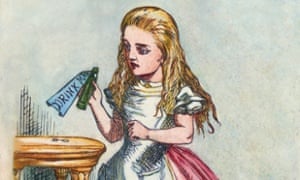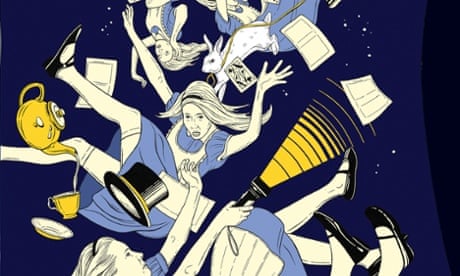Lewis Carroll
Alice in Wonderland – what does it all mean?
After 150 years, the search for the meaning behind Alice’s fantastical excursions has provoked many elaborate theories. Here are five of the most popular
 ‘Sometimes a bottle is just a bottle,’ Alice didn’t say. Photograph: Bettmann/Corbis
‘Sometimes a bottle is just a bottle,’ Alice didn’t say. Photograph: Bettmann/CorbisRobert Douglas-Fairhurst
Friday 20 March 2015 11.00 GMT
Alice’s Adventures in Wonderland is infinitely greater than its critics. Of the thousands of books and articles it has inspired over the past 150 years, very few treat it simply as a piece of joyful nonsense. More often it has been viewed as a mystery requiring a solution, with every detail being cross-examined in the hope that it will crack under pressure and reveal what Carroll is really up to. Here are some of the most popular theories.

Alice in Wonderland: the never-ending adventures
Sex
While the story invites us to step inside Alice’s head, some readers have wondered if it reveals more about her creator. Psychoanalytical interpreters have seized on it with particular relish. William Empson gleefully pointed out that Alice is “a father in getting down the hole, a foetus at the bottom, and can only be born by becoming a mother and producing her own amniotic fluid”. Alice’s attempts to move aside a curtain and squeeze through a little doorway have also attracted comment, particularly when viewed alongside Carroll’s history of child friendships. His defenders point out that such interpretations probably reveal more about our own fears than they do about Carroll.
Drugs
Even more popular is the theory that Alice’s Adventures in Wonderland is a thinly veiled allegory about drug use. Songs such as Jefferson Airplane’s “White Rabbit”(“Remember what the Dormouse said / Feed your head, feed your head”) have encouraged a whole generation of readers to think of Alice’s journey underground as another kind of trip. Actually there is no evidence that Carroll ever tried drugs beyond some alarming-sounding homeopathic remedies, which included dosing himself with “aconite and arsenic” to cure a stubborn cold. But for many people, the hookah-smoking Caterpillar and his magic mushroom remain far more closely associated with the 1960s than the 1860s.
Even more popular is the theory that Alice’s Adventures in Wonderland is a thinly veiled allegory about drug use. Songs such as Jefferson Airplane’s “White Rabbit”(“Remember what the Dormouse said / Feed your head, feed your head”) have encouraged a whole generation of readers to think of Alice’s journey underground as another kind of trip. Actually there is no evidence that Carroll ever tried drugs beyond some alarming-sounding homeopathic remedies, which included dosing himself with “aconite and arsenic” to cure a stubborn cold. But for many people, the hookah-smoking Caterpillar and his magic mushroom remain far more closely associated with the 1960s than the 1860s.
Jokes
Some parts of Carroll’s story assume a degree of local knowledge. For example, the Duck, Dodo, Lory and Eaglet are walk-on parts for Duckworth, Dodgson and Alice’s sisters Ina and Edith, while the description of them emerging “dripping wet, cross and uncomfortable” from the pool of tears is a distorted echo of an earlier boating trip during which they were caught in a thunderstorm. There are many other local references: there is a real treacle healing well near Oxford in the village of Binsey, and Alice also plays a grotesque version of the croquet games she would have enjoyed in Christ Church. In fact many critics are convinced that the whole story is so full of references to the city that it should be viewed as an elaborate Oxford in-joke.
Food
Starting with a bottle (“DRINK ME”) that makes Alice shut up like a telescope, and a cake (“EAT ME”) that turns her into a giant, Carroll’s story often returns to the subject of food and drink. This isn’t always straightforward (the Hatter’s tea party turns out to be a party without any tea), but many of Wonderland’s creatures spend their time either eating or worrying about being eaten. Some critics have suggested that the story is partly about eating disorders, pointing out that Carroll himself was rake-thin and rarely ate more than biscuit for lunch. Others have seen it as an elaborate celebration of the picnic teas he provided for the Liddell children. What almost everyone agrees on is that Alice’s sudden physical changes comically reflect on an inevitable fact of life. Fictional children can stay the same age forever, but real children grow up.
Dreams
“The whole thing is a dream,” Carroll told the dramatist Tom Taylor, “but that I don’t want revealed till the end.” Beginning with a rabbit that disappears and reappears, like a magic trick that has infiltrated real life, Carroll’s story develops by generating a real dream’s characteristic mixture of vagueness and vividness. Nothing remains the same for long. Even words start to blur into each other. “Did you say ‘pig’ or ‘fig’?” asks the Cheshire Cat, who appears only after the Caterpillar has disappeared. (In real life a caterpillar becomes a butterfly; in dreams a caterpillar becomes a cat.) Usually it is an empty cliche to say that someone writes like a dream, but this is exactly what Carroll tried to do. His story pulled apart the world around him and reassembled it in a crazily jumbled form.
Robert Douglas-Fairhurst’s The Story of Alice is published by Harvill Secker.
Some parts of Carroll’s story assume a degree of local knowledge. For example, the Duck, Dodo, Lory and Eaglet are walk-on parts for Duckworth, Dodgson and Alice’s sisters Ina and Edith, while the description of them emerging “dripping wet, cross and uncomfortable” from the pool of tears is a distorted echo of an earlier boating trip during which they were caught in a thunderstorm. There are many other local references: there is a real treacle healing well near Oxford in the village of Binsey, and Alice also plays a grotesque version of the croquet games she would have enjoyed in Christ Church. In fact many critics are convinced that the whole story is so full of references to the city that it should be viewed as an elaborate Oxford in-joke.
Food
Starting with a bottle (“DRINK ME”) that makes Alice shut up like a telescope, and a cake (“EAT ME”) that turns her into a giant, Carroll’s story often returns to the subject of food and drink. This isn’t always straightforward (the Hatter’s tea party turns out to be a party without any tea), but many of Wonderland’s creatures spend their time either eating or worrying about being eaten. Some critics have suggested that the story is partly about eating disorders, pointing out that Carroll himself was rake-thin and rarely ate more than biscuit for lunch. Others have seen it as an elaborate celebration of the picnic teas he provided for the Liddell children. What almost everyone agrees on is that Alice’s sudden physical changes comically reflect on an inevitable fact of life. Fictional children can stay the same age forever, but real children grow up.
Dreams
“The whole thing is a dream,” Carroll told the dramatist Tom Taylor, “but that I don’t want revealed till the end.” Beginning with a rabbit that disappears and reappears, like a magic trick that has infiltrated real life, Carroll’s story develops by generating a real dream’s characteristic mixture of vagueness and vividness. Nothing remains the same for long. Even words start to blur into each other. “Did you say ‘pig’ or ‘fig’?” asks the Cheshire Cat, who appears only after the Caterpillar has disappeared. (In real life a caterpillar becomes a butterfly; in dreams a caterpillar becomes a cat.) Usually it is an empty cliche to say that someone writes like a dream, but this is exactly what Carroll tried to do. His story pulled apart the world around him and reassembled it in a crazily jumbled form.
Robert Douglas-Fairhurst’s The Story of Alice is published by Harvill Secker.